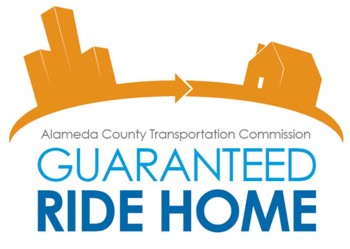Guaranteed Ride Home Closes the Loop in Sustainable Transportation
Guaranteed Ride Home Closes the Loop in Sustainable Transportation

Funding for many transportation-related programs has been shrinking, but Guaranteed Ride Home (GRH) is standing strong. This 14-year-old incentive to encourage sustainable commuting addresses one of the chief justifications people use for driving alone: When you don't drive your own car to the workplace, getting back home in case of emergency is a big concern.
"We know that employees at work will occasionally face unexpected circumstances that will require them to have transportation at the ready, whether due to illness, a family crisis, or unscheduled overtime," explains Adina Ringler, the administrator of the program, now managed by the Alameda County Transportation Commission.
GRH provides that important back-up. In an emergency, carpoolers, transit users, and others who did not drive alone to work can get home on their own, outside their normal commuting arrangements, either by cab or rental car. Promised response time for the taxi, dispatched by a company contracted to provide the service, is 15 minutes. Rental cars are recommended for those who live more than 20 miles away. Enterprise, the car agency, offers a pick-up service, along with a ride from its branch office back to work the next day. If a stop is needed en route - picking up a child at school or getting a prescription filled, for example - that's included, too.
GRH is a free commuter benefit, part of the Transportation Commission's long-term goal of reducing congestion and improving air quality. Employers must first sign up for the program and designate a contact person before their workers can participate. To be eligible, employees must have taken public transit, a carpool or vanpool, or walked or biked to work, and live within 100 miles of their worksite. A voucher system eliminates the need for reimbursement, so the employee has no out-of-pocket expenses.
"When you enroll in the program, we send you a packet of information and a ride voucher. That's what you give to the taxi driver or the car rental agency," Ringler says.
GRH has seen steadily improving results since its inception in 1998. "We just completed our 2011 annual evaluation," Ringler reports. Based on extrapolation, the number of one-way drive-alone trips in Alameda County was down by 405,496 in the year. At the end of April, 270 employers and 5,000 employees were enrolled in the program in Alameda County, compared to the previous year's figures of 208 and 4,300, respectively-good signs of growth. Another indication of continuing good prospects for the program is that grant funding, which comes from the Bay Area Air Quality Management District Transportation Fund for Clean Air, is stable.
Ringler's office is in the midst of updating the program website, streamlining materials, and launching an engaging social media campaign. "People tend to tuck the packet away in their desk and forget about the program," she notes. "By using social media we can stay in touch and keep them aware of this option. It is all part of encouraging the use of sustainable modes of transportation."
While GRH utilization among Hacienda businesses is good, Ringler says she would like to see all employers sign up for this free, easy-to-use benefit. For more information, select the "Order Materials" option from the Tools menu at www.hacienda.org, visit alamedagrh.org, or call Ringler at (510) 433-0320.
Also in this issue...
- Two New Hacienda Housing Communities Receive Green Light from City
- Purity Day Spa Offers Oasis of Tranquility to Help Shed Stress
- Business Bits
- Executive Profile: George Mathew, Latex Global
- Cherry Creek Mortgage Company Blends Innovation with a Responsible Lending Approach
- ValleyCare Health Library is Beneficiary of Upcoming Golf Scramble
- For Business or Pleasure, a Day or a Month, Hacienda has a Hotel for You
- Guaranteed Ride Home Closes the Loop in Sustainable Transportation
- Safe Routes to School Projects Include 'Bike Train' and 'Walking School Bus'
- Green Business Certification Offers Multitude of Benefits
- Summer in Downtown Pleasanton
- Hacienda Online!
- Top 10 Reasons to Join the Pleasanton Chamber of Commerce
- Hacienda Index
- Calendar




